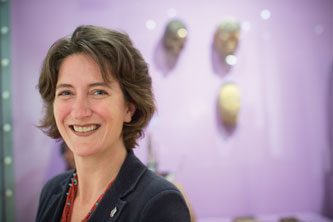Art: Found Objects
Contemporary African art encompasses a variety of styles and techniques, and the creative transformation of discarded, found and ready-made materials into works of art influences many contemporary African art practices. For art historian Susan Kart, found object art has led her to reconsider the history of sculpture and the use of figuration in sculpture from the colonial period to the present.
Kart, assistant professor of art history in the department of art, architecture and design and a member of the Africana Studies program, has focused on Moustapha Dimé, a Senegalese sculptor who passed away in 1998 but was important to the establishment of the Senegalese found object art movement. The author of the forthcoming book Found Objects, Kart examines Dimé’s work within the context of the avant-garde movement in Senegal, its connection to the colonial past and the future of independence.
Kart also studies the history of European collection of African art, specifically figurative forms—figurative sculptures and anthropomorphic items that were brought to Europe as exotic commodities from the colonial territories.
“The European colonial collectors were not really interested in things that were completely abstract, nonfigurative or decorative as defined by the European colonial tastes of the time,” she says. “As a result, we have massive collections of African figurative sculpture in the U.S. and Europe. The objects were collected primarily in the late 19th and early 20th century. It’s a very small snippet of the artworks of certain cultures as observed from the outside and collected within a 100-year span.”
These works are influencing contemporary artists, and Kart studies the associations between these historical objects in their own contexts—mediated through the colonial collections—and how they become the core of materials being examined and questioned by current artists dealing with the figure in sculpture.
“The idea of the found object is highly relevant for contemporary artists. They examine the objects in European and American museums as found objects: objects dislocated from the past that can be reinvented. This is parallel to the way an artist like El Anatsui (Ghana) might take bottle caps and turn them into a contemporary sculpture that looks like a traditional textile in some way. There’s an interesting theoretical link.”
There is a challenge to working with material spread across three continents. Kart has access to American archives and American materials, but as a historian, she is obligated to work in Europe, where the colonial archives are located. The contemporary piece of her scholarship is working with African artists who are situated around the globe or else remain in their countries of origin.
“I see myself as an interlocutor or translator for this material. I don’t make the claim to be an expert on African art, but rather I’m working to best present the material to an audience who is not yet familiar with it. I hope to use this material to widen the perspective of an American audience and have students gain a nuanced view of Africa. I want them to be able to understand these countries as the contemporary, dynamic, culture-producing places they have always been.”
The findings in African art history are constantly being rethought, as every new generation of art historians debunks the findings of their predecessors, which requires Kart to stay current with the latest findings.
“The information changes so quickly, but it’s very satisfying that I get to provide students with the newest information every year from my research in Senegal and elsewhere. Most American students don’t have access to any of this. At Lehigh, we operate on the cutting edge, whether in engineering, community health and, yes, even art history! As research faculty, we’re constantly discovering new information and bringing it immediately into the classroom. I am incredibly passionate about that!”
Photos by Douglas Benedict
Posted on:



